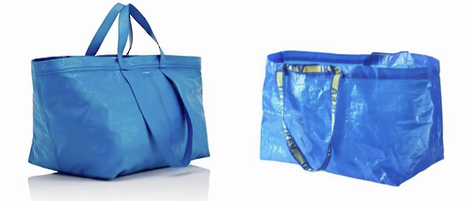Balenciaga and the art of the ordinary
Following the release of Balenciaga’s ‘IKEA’ tote bag, Megan Lea writes that anything can be fashion if you want it to be

Balenciaga has traditionally had a reputation as a purveyor of luxury, femininity, and fine couture. However, it might come as a shock to some to see the French house’s latest sartorial offerings, particularly the large blue tote bag which is clearly reminiscent of those unbeatably practical royal-blue plastic sacks, notorious for populating the aisles of IKEA, everyone’s favourite furniture paradise.
It’s a perfect example of the satirical, ordinary-fashion-as-high-fashion schtick of creative director Demna Gvasalia, who took over from Alexander Wang in October last year. Just like Gvasalia’s much-talked about work at his own brand Vetements, it raises a lot of questions. Is it a joke? Is it genius? Or is it a coup de grace for consumerism, beautifying the mundane with a trendy name and exorbitant price-tag while the ‘real deal’ remains worthless – to the casual observer, the same object is a symbol both of wealthy high status and of just the opposite.
Issues of classism are impossible to avoid in cases like this. At the same time, and indeed in virtue of its divisiveness, the Balenciaga bag is a great example of how contemporary fashion is like contemporary art. What with Gvasalia’s work at Vetements – and now Balenciaga – as well as the general appropriation by fashion designers of an endless stream of ‘ugly’ items in recent years (see: Christopher Kane’s crocs, Céline’s fur-lined Birkenstocks, Versace’s skin-tight, neon-bright athletic wear), fashion has really cemented its place as an art form.
“Regardless, the conversations this sort of fashion introduces are rich and definitely worth having”.
This is nothing new, of course. For beauty and craftsmanship, haute couture has always been gallery-worthy. For innovation, there have always been those pushing the boundaries of how to dress, from Coco Chanel to Vivienne Westwood. And for ‘artsy’ fashion, look no further than the likes of Alexander McQueen, Martin Margiela, and Rei Kawakubo. What is different about the kind of fashion that looks more like it came straight from the wardrobe of a middle-aged postman is… well, just that. This is fashion that is not recognisable as fashion; not until you see the label, that is, or watch the runway show, or see it in the pages of Vogue. The complaints levied against clothes like this could well be taken straight from the mouths of those extolling the evils of Jeff Koons or Tracey Emin. The classic retort of I could have done that could well be applied to the act of calling a simple hoodie, DHL t-shirt, or IKEA bag ‘fashion’.
When Marcel Duchamp put a urinal on display under the title ‘Fountain’, to some it was preposterous, to others a stroke of genius. However, one big difference between the art world and the fashion world is the role of commerce. Put in the context of its $2,145 price tag, Balenciaga’s IKEA bag is, unfortunately, more than just satire or Dadaism: when everyday clothes and items are appropriated from, for want of a better word, normal people and re-enter the market at grotesquely inflated levels of price and prestige, it serves to widen the gap between the (ever more similar in outward appearance) cool rich and the uncool poor, a self-sustaining system that is unnerving in its irony.
It is perhaps unfair to lay all the blame on Gvasalia though. After all, he has stated that he would never buy the clothes at Vetements himself; it is he who is commenting on consumers. He was not even the first to play this particular trick: in 2007, Louis Vuitton, under the tenure of Marc Jacobs, showed a leather tote inspired by the roomy red and white plaid bags often seen on the street (i.e. the real street). The concept of taking inspiration from every aspect of society and turning it into fashion probably won’t go away anytime soon. It is one that I can’t decide whether to love or hate. Regardless, the conversations this sort of fashion introduces are rich and definitely worth having.
Is the act of taking an ordinary object or piece of clothing out of context enough to elevate it to the status of art, or in this instance, fashion? If enough people are paying attention (and being a famous designer or trend-setting celebrity helps with that), then maybe so. Regardless, arguably the best reaction to the Balenciaga bag is a marketing poster from IKEA itself: “How to identify an original IKEA FRAKTA BAG – price tag only $0.99”. Art isn’t art until someone says it is; in much the same way, it would seem that anything is ‘fashion’ if Demna Gvasalia says it is.
 News / Caius mourns its tree-mendous loss23 December 2025
News / Caius mourns its tree-mendous loss23 December 2025 News / Cambridge welcomes UK rejoining the Erasmus scheme20 December 2025
News / Cambridge welcomes UK rejoining the Erasmus scheme20 December 2025 News / CUP announces funding scheme for under-represented academics19 December 2025
News / CUP announces funding scheme for under-represented academics19 December 2025 News / King appoints Peterhouse chaplain to Westminster Abbey22 December 2025
News / King appoints Peterhouse chaplain to Westminster Abbey22 December 2025 Interviews / Politics, your own way: Tilly Middlehurst on speaking out21 December 2025
Interviews / Politics, your own way: Tilly Middlehurst on speaking out21 December 2025







